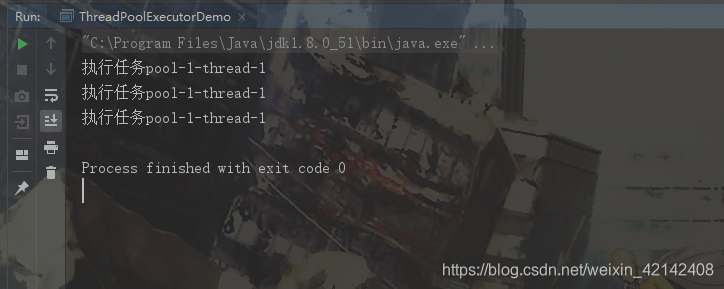一、线程池的介绍
线程池一种性能优化的重要手段。优化点在于创建线程和销毁线程会带来资源和时间上的消耗,而且线程池可以对线程进行管理,则可以减少这种损耗。
使用线程池的好处如下:
- 降低资源的消耗
- 提高响应的速度
- 提高线程的可管理性
二、线程池的使用
public class ThreadPoolExecutorDemo {
static class Worker implements Runnable{
@Override
public void run() {
try {
Thread.sleep(10_000);
} catch (InterruptedException e) {
e.printStackTrace();
}
System.out.println("执行任务"+Thread.currentThread().getName());
}
}
public static void main(String[] args) {
Worker worker1 = new Worker();
Worker worker2 = new Worker();
Worker worker3 = new Worker();
ExecutorService executorService = Executors.newFixedThreadPool(1);
executorService.submit(worker1);
executorService.submit(worker2);
executorService.submit(worker3);
executorService.shutdown();
}
}
运行结果

如果将线程池的大小设置为3,Executors.newFixedThreadPool(3);,则运行结果如下:

public static void main(String[] args) {
Worker worker1 = new Worker();
ThreadPoolExecutor executor = new ThreadPoolExecutor(1, 2,
0L, TimeUnit.MILLISECONDS,
new LinkedBlockingQueue<Runnable>(4));
for(int i=0;i<9;i++) {
executor.submit(worker1);
}
executor.shutdown();
}运行结果
Exception in thread "main" java.util.concurrent.RejectedExecutionException: Task java.util.concurrent.FutureTask@677327b6 rejected from java.util.concurrent.ThreadPoolExecutor@14ae5a5[Running, pool size = 2, active threads = 2, queued tasks = 4, completed tasks = 0]
at java.util.concurrent.ThreadPoolExecutor$AbortPolicy.rejectedExecution(ThreadPoolExecutor.java:2047)
at java.util.concurrent.ThreadPoolExecutor.reject(ThreadPoolExecutor.java:823)
at java.util.concurrent.ThreadPoolExecutor.execute(ThreadPoolExecutor.java:1369)
at java.util.concurrent.AbstractExecutorService.submit(AbstractExecutorService.java:112)
at com.fonxian.baseuse.ThreadPoolExecutorDemo.main(ThreadPoolExecutorDemo.java:27)
执行任务pool-1-thread-2
执行任务pool-1-thread-1
执行任务pool-1-thread-2
执行任务pool-1-thread-1
执行任务pool-1-thread-1
执行任务pool-1-thread-2三、线程池的实现原理

- 线程池先判断核心线程池中的所有线程是否都在执行任务,若否,创建新任务,若是进入下一个流程
- 线程池判断工作队列是否已满,未满,任务加入队列,若满,进入下个流程
- 线程池判断线程池中的线程是否都在执行任务,若是,则创建新任务,若否,交给饱和策略处理任务。

四、ThreadPoolExecutor源码
2.1 类依赖关系

2.2 源码解析
成员变量
public class ThreadPoolExecutor extends AbstractExecutorService {
//工作队列
private final BlockingQueue<Runnable> workQueue;
//核心线程池大小
private volatile int corePoolSize;
//最大线程池大小
private volatile int maximumPoolSize;
private static final RejectedExecutionHandler defaultHandler =
new AbortPolicy();
}
execute方法
//ctl, is an atomic integer packing two conceptual fields
//workerCount, indicating the effective number of threads
//runState, indicating whether running, shutting down etc
private final AtomicInteger ctl = new AtomicInteger(ctlOf(RUNNING, 0));
/*
* Proceed in 3 steps:
*
* 1. If fewer than corePoolSize threads are running, try to
* start a new thread with the given command as its first
* task. The call to addWorker atomically checks runState and
* workerCount, and so prevents false alarms that would add
* threads when it shouldn't, by returning false.
* 如果小于正在运行的核心线程池的线程数,则尝试开启一个新线程运行任务。
*
* 2. If a task can be successfully queued, then we still need
* to double-check whether we should have added a thread
* (because existing ones died since last checking) or that
* the pool shut down since entry into this method. So we
* recheck state and if necessary roll back the enqueuing if
* stopped, or start a new thread if there are none.
*
* 3. If we cannot queue task, then we try to add a new
* thread. If it fails, we know we are shut down or saturated
* and so reject the task.
*/
public void execute(Runnable command) {
if (command == null)
throw new NullPointerException();
int c = ctl.get();
//当前线程数小于核心线程池大小,则创建线程执行当前任务。
if (workerCountOf(c) < corePoolSize) {
if (addWorker(command, true))
return;
c = ctl.get();
}
//如果当前线程数大于核心线程池大小或线程创建失败,则将任务放到工作队列中
if (isRunning(c) && workQueue.offer(command)) {
int recheck = ctl.get();
if (! isRunning(recheck) && remove(command))
reject(command);
else if (workerCountOf(recheck) == 0)
addWorker(null, false);
}
//抛出RejectedExecutionException异常
else if (!addWorker(command, false))
reject(command);
}
构造方法
/**
* Creates a new {@code ThreadPoolExecutor} with the given initial
* parameters.
*
* @param corePoolSize the number of threads to keep in the pool, even
* if they are idle, unless {@code allowCoreThreadTimeOut} is set
* @param maximumPoolSize the maximum number of threads to allow in the
* pool
* @param keepAliveTime when the number of threads is greater than
* the core, this is the maximum time that excess idle threads
* will wait for new tasks before terminating.
* @param unit the time unit for the {@code keepAliveTime} argument
* @param workQueue the queue to use for holding tasks before they are
* executed. This queue will hold only the {@code Runnable}
* tasks submitted by the {@code execute} method.
* @param threadFactory the factory to use when the executor
* creates a new thread
* @param handler the handler to use when execution is blocked
* because the thread bounds and queue capacities are reached
* @throws IllegalArgumentException if one of the following holds:<br>
* {@code corePoolSize < 0}<br>
* {@code keepAliveTime < 0}<br>
* {@code maximumPoolSize <= 0}<br>
* {@code maximumPoolSize < corePoolSize}
* @throws NullPointerException if {@code workQueue}
* or {@code threadFactory} or {@code handler} is null
*/
public ThreadPoolExecutor(int corePoolSize,//核心线程池大小
int maximumPoolSize,//最大线程池大小
long keepAliveTime,//线程活动保持时间
TimeUnit unit,//线程活动保持时间单位
BlockingQueue<Runnable> workQueue,
ThreadFactory threadFactory,
RejectedExecutionHandler handler) {
if (corePoolSize < 0 ||
maximumPoolSize <= 0 ||
maximumPoolSize < corePoolSize ||
keepAliveTime < 0)
throw new IllegalArgumentException();
if (workQueue == null || threadFactory == null || handler == null)
throw new NullPointerException();
this.corePoolSize = corePoolSize;
this.maximumPoolSize = maximumPoolSize;
this.workQueue = workQueue;
this.keepAliveTime = unit.toNanos(keepAliveTime);
this.threadFactory = threadFactory;
this.handler = handler;
}频繁RejectedExecutionException的解决方案
参考文档
《Java并发编程的艺术》
Java并发--深入理解线程池
扫描二维码关注公众号,回复:
6217407 查看本文章

